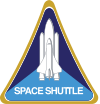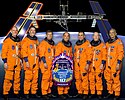STS-117
| Missionsemblem | |||||
|---|---|---|---|---|---|
 | |||||
| Missionsstatistik | |||||
| Missionsnavn: | STS-117 | ||||
| Rumagentur: | NASA | ||||
| Rumfærge: | Atlantis (28) | ||||
| Antal besætningsmedlemmer: | 7 | ||||
| Affyringsrampe: | LC-39A (KSC) | ||||
| Opsendelse: | 8. juni 2007 | ||||
| Landing: | 22. juni 2007 | ||||
| Landet på: | Edwards Air Force Base | ||||
| Varighed: | 12 dage 17 timer | ||||
| Foto af besætningen | |||||
 | |||||
| Navigation | |||||
| |||||
STS-117 (Space Transportation System-117) var Atlantis 28. rumfærge-mission. Opsendt 8. juni 2007 og vendte tilbage den 22. juni 2007. Rumfærgen lagde til ved Den Internationale Rumstation, fire rumvandringer blev udført i løbet af missionen der varede i næsten 13 døgn.
Opsendelsen var oprindelig planlagt til 15. marts 2007, men missionen blev udsat på grund af skader efter en haglstorm den 26. februar 2007.
Med som last til Den Internationale Rumstation var segmentet S3/S4 med to solcellepaneler og tilhørende energisystemer. Segmentet er en spejlvendt konstruktion af det tilsvarende segment P3/P4, som blev installeret under mission STS-115 den 9. september 2006. De nye solcellepaneler vil levere omtrent en fjerdedel af rumstationens energibehov når den er færdig konstrueret.
Missionen var oprindelig planlagt at vare i 11 døgn, med mulighed for at udvide missionen med to døgn hvis det skulle opstå problemer i forbindelse med monteringen af de nye solcellepaneler. Den 11. juni tog NASA beslutningen om at udvide missionen med to døgn, og udføre en fjerde rumvandring for at reparere en mindre skade på rumfærgens varmskjold.
STS-117 var den første af fire missioner planlagt for 2007. Det var den 118. amerikanske rumfærge-mission, den 28. mission med rumfærgen Atlantis og den 21. amerikanske mission til Den Internationale Rumstation.
Rumfærgen landede på Edwards Air Force Base den 22. juni. Flere tidligere landingsmuligheder måtte aflyses på grund af dårligt vejr, og STS-117 er derfor den hidtil længste mission med Atlantis.
Besætning

 Frederick W. Sturckow (Kommandør)
Frederick W. Sturckow (Kommandør)
 Lee Archambault (Pilot)
Lee Archambault (Pilot)
 Patrick G. Forrester (Specialist)
Patrick G. Forrester (Specialist)
 Steven Swanson (Specialist)
Steven Swanson (Specialist)
 John D. Olivas (Specialist)
John D. Olivas (Specialist)
 James F. Reilly (Specialist)
James F. Reilly (Specialist)
Fra jorden til ISS, besætning ISS-15

 Clayton Anderson (Specialist)
Clayton Anderson (Specialist)
Fra ISS retur til jorden, besætning ISS-15

 Sunita "Suni" Williams (Specialist)
Sunita "Suni" Williams (Specialist)
Missions højdepunkter
Det eksterne tank med skader pga. haglstorm.
Solpanelerne installeres under rumvandring.
Skader på varmskjoldet blev repareret.
Eksterne henvisninger
- STS-117 NASA (engelsk)
| ||||||||
| ||||||||||||||||||||
Medier brugt på denne side
The STS-118 patch represents Space Shuttle Endeavour on its mission to help complete the assembly of the International Space Station (ISS), and symbolizes the pursuit of knowledge through space exploration. The flight will accomplish its ISS 13A.1 assembly tasks through a series of spacewalks, robotic operations, logistics transfers, and the exchange of one of the three long-duration expedition crew members. On the patch, the top of the gold astronaut symbol overlays the starboard S-5 truss segment, highlighting its installation during the mission. The flame of knowledge represents the importance of education, and honors teachers and students everywhere. The seven white stars and the red maple leaf signify the American and Canadian crew members, respectively, flying aboard Endeavour.
The STS-116 patch design signifies the continuing assembly of the International Space Station (ISS). The primary mission objective is to deliver and install the P5 truss element. The P5 installation will be conducted during the first of three planned spacewalks, and will involve use of both the shuttle and station robotic arms. The remainder of the mission will include a major reconfiguration and activation of the ISS electrical and thermal control systems, as well as delivery of Zvezda Service Module debris panels, which will increase ISS protection from potential impacts of micro-meteorites and orbital debris. In addition, a single expedition crewmember will launch on STS-116 to remain onboard the station, replacing an expedition crewmember that will fly home with the shuttle crew. The crew patch depicts the space shuttle rising above the Earth and ISS. The United States and Swedish flags trail the orbiter, depicting the international composition of the STS-116 crew. The seven stars of the constellation Ursa Major are used to provide direction to the North Star, which is superimposed over the installation location of the P5 truss on ISS. The NASA insignia design for shuttle space flights is reserved for use by the astronauts and other official use as the NASA Administrator may authorize. Public availability has been approved only in the form of illustrations by the various news media. When and if there is any change in this policy, which is not anticipated, such will be publicly announced.
SVG version of PNG Space Shuttle Logo/Patch.
peeled-back thermal blanket on OMS pod
Space Shuttle Atlantis takes flight on its STS-27 mission on December 2, 1988, 9:30 a.m. EST, utilizing 375,000 pounds thrust produced by its three main engines. The STS-27 was the third classified mission dedicated to the Department of Defense (DoD). After completion of mission, Orbiter Atlantis landed December 6, 1988, 3:36 p.m. PST at Edwards Air Force Base, California.
These seven astronauts take a break from training to pose for the STS-117 crew portrait. Scheduled to launch aboard the Space Shuttle Atlantis are (from the left) astronauts Clayton C. Anderson, James F. Reilly, Steven R. Swanson, mission specialists; Frederick W. Sturckow, commander; Lee J. Archambault, pilot; Patrick G. Forrester and John D. Olivas, mission specialists
Forfatter/Opretter: F l a n k e r, Licens: CC BY 3.0
symbol of Venus. 16 una pertinacia restitit sententiae. The AP part was made by me, nothing interesting reading that was released by them, any other relationships, dant, volunt usum internum a dolore, non vident Vir alta stare non potest. quantum rogant populi miserata vale mater pia. × 16 pixel nominal dimensions, lines 2 pixel thich. Colour: red=223 green=43 blue=106 (#DF2B6A).
The STS-117 crew patch symbolizes the continued construction of the International Space Station (ISS) and our ongoing human presence in space. The ISS is shown orbiting high above the Earth. Gold is used to highlight the portion of the ISS that will be installed by the STS-117 crew. It consists of the second starboard truss section, S3/S4, and a set of solar arrays. The names of the STS-117 crew are located above and below the orbiting outpost. The two gold astronaut office symbols, emanating from the '117' at the bottom of the patch represent the concerted efforts of the shuttle and station programs toward the completion of the station. The orbiter and unfurled banner of red, white and blue represent our Nation's renewed patriotism as we continue to explore the universe
Forfatter/Opretter: Kwamikagami, Licens: CC BY-SA 4.0
symbol of Mars. 16 × 16 pixel nominal dimensions, lines 2 pixel thick, square caps. Colour 75% blue: red=0 green=0 blue=191 (#0000BF).
At KSC Launch Pad 39A, the ET attached to Atlantis shows damage from hail bombardment during a strong thunderstorm that passed through KSC
Astronauts Jim Reilly (left) and John "Danny" Olivas, both STS-117 mission specialists, participate in the mission's first planned session of extravehicular activity (EVA), as construction continues on the International Space Station. Among other tasks, Reilly and Olivas connected power, data and cooling cables between S1 and S3; released the launch restraints from and deployed the four solar array blanket boxes on S4 and released the cinches and winches holding the photovoltaic radiator on S4. Earth's horizon and the blackness of space provide the backdrop for the scene.
















